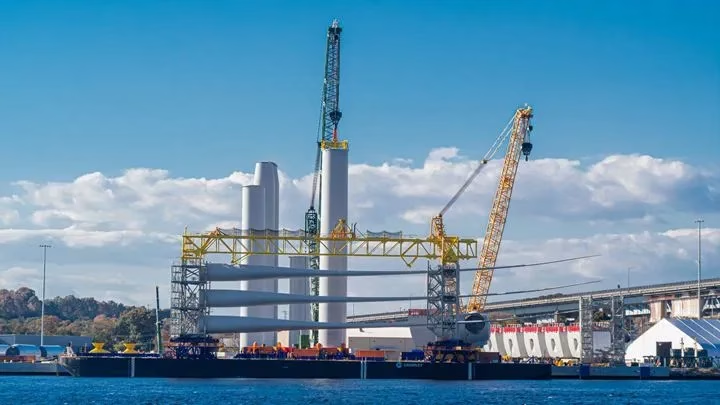Update: As of November 2025, Ørsted’s 704 MW Revolution Wind project has resumed construction following a court injunction that lifted a controversial federal stop-work order issued in August 2025. The project is approximately 80% complete and remains on track for commissioning in the second half of 2026. Located 15 miles south of the Rhode Island coast and 32 miles southeast of the Connecticut coast, the project is designed to power approximately 350,000 homes across those two states once fully operational.
Construction Resumes: A U.S. federal judge granted a preliminary injunction in late September 2025, allowing offshore construction to restart while a lawsuit against the Interior Department proceeds through the courts. Ørsted had argued the stop-work order was “arbitrary and capricious” and was costing the project over $2 million per day in idle vessel time.
In August 2025, the Trump administration issued a stop-work order on the Empire Wind 1 offshore project, halting construction off the coast of New York. The order, signed on August 16, 2025 by Interior Secretary Doug Burgum, claimed that the project’s approvals had been rushed and required further review. The suspension dealt a major blow to Equinor, the project’s developer, and immediately stalled offshore construction activity. In contrast, Europe has continued to push forward with major offshore ventures, including RWE’s massive 1.6 GW Nordseecluster wind farm in Germany. It has recently secured approval to proceed.
The halt lasted for about one month, with operations resuming in mid-September 2025 after mounting political pressure and negotiations. Other than the Revolution Wind project, Trump’s administration has come under fire in latest construction projects such as his ambitious $200 million ballroom. Construction of the white house ballroom takes shape as demolition commences on parts of the building’s East wing. Demolition is already making decent headway as excavators tear on the side of the building. The East wing area has often been regarded as the base of operations for the first lady. However, Trump aims to establish a $200 million ballroom that will be funded by private donors as well as himself. Despite this, construction officials had earlier noted that construction would not affect the East wing.
Part of Wider Crackdown on Renewables
The decision is part in a series of policy moves that have slowed U.S. renewable energy expansion. President Trump, a vocal critic of wind energy, issued a moratorium on new offshore wind projects earlier this year. Atlantic Shores another offshore wind project has thrown in the towel due to the adverse environment.
The Internal Revenue Service has also tightened guidelines that make it more difficult for developers of wind and solar facilities to qualify for federal tax incentives. At the same time, the Commerce Department is investigating whether imports of wind turbines and related components pose a national security risk.
Due to uncertainties and policy changes under the Trump administration, some utilities have leaned toward natural gas power generation—a choice that has drawn criticism over continued reliance on fossil fuels, as seen in JEA’s $1.57 billion plan for a new combined cycle plant in North Jacksonville.
Ørsted’s Response and Industry Concerns
Ørsted stated it is “evaluating all options to resolve the matter expeditiously,” including possible legal action. Construction of Revolution Wind began in 2023. They plan to deliver electricity to households and businesses in Rhode Island and Connecticut by 2026.
Industry leaders have expressed concern over the decision’s broader impact. Erik Milito, president of the National Ocean Industries Association, warned that delays could ripple across jobs, contracts, and communities that are already benefiting from the project. He emphasized that the U.S. currently has only one fully operational large-scale offshore wind farm. Furthermore, this is far below what is needed to meet the nation’s growing energy demands.
Potential Impact on Energy Markets
Analysts caution that limiting renewable energy development at a time of rising electricity demand could contribute to higher power prices nationwide. With the country pushing for energy diversification, stakeholders argue that offshore wind, alongside oil, gas, and emerging technologies, is critical for long-term energy security. Meanwhile, over in Australia, the government has taken a different direction with the recent approval of the Robbins Island Wind Project. In addition, the 900 MW project has been in the works for 8 years and is set to be undertaken by ACEN Australia.
Offshore wind projects across the industry are consistently facing cost overruns and delays, exemplified by Dominion Energy’s Coastal Virginia Offshore Wind project, which recently saw its estimated cost climb to $11.2 billion.
Revolution Wind Project Factsheet
Project Overview
-
Name: Revolution Wind
-
Type: Offshore wind farm (first multi-state project in the U.S.)
-
Capacity: 704 MW
-
400 MW to Rhode Island
-
304 MW to Connecticut
-
Powering over 350,000 homes
-
-
Emissions Offset: Avoids over 1 million metric tons of CO₂ annually—equivalent to removing about 150,000 cars from the road
Location
-
Federal Waters: Approximately 15 miles south of the Rhode Island coast, 32 miles southeast of Connecticut, and 12 miles southwest of Martha’s Vineyard
-
Lease Area: BOEM’s OCS-A 0486; separated from a larger lease area in 2020
Development Partners
-
Developers: Ørsted and Global Infrastructure Partners (Skyborn Renewables)
-
History: Initially partnered with Eversource, which exited ownership in 2024
Technology & Infrastructure
-
Turbines: 65 Siemens Gamesa 11 MW (11.0-200 DD)
-
Transmission: Subsea cables to Quonset Business Park (Rhode Island), then underground to the Davisville substation and into the regional grid
Timeline & Permitting
-
Environmental Review: Draft EIS released in August 2022; Final EIS and Joint Record of Decision signed in August 2023 by BOEM, NMFS, and USACE
-
Construction: Began in 2023
-
First Turbine Installed: September 2024
-
Target Commercial Operation Date (COD): 2026

